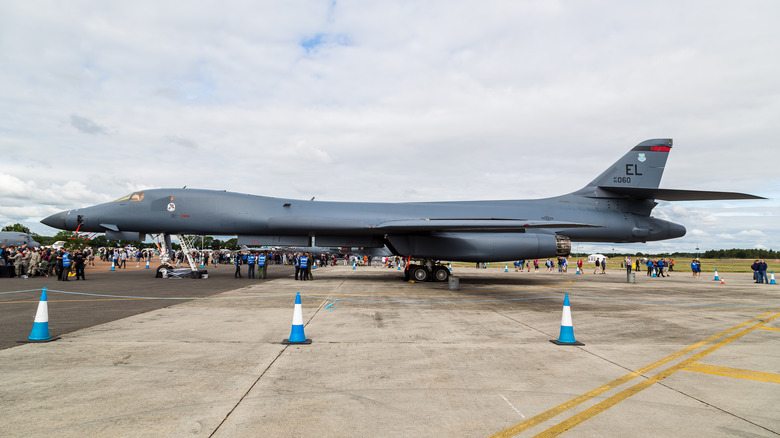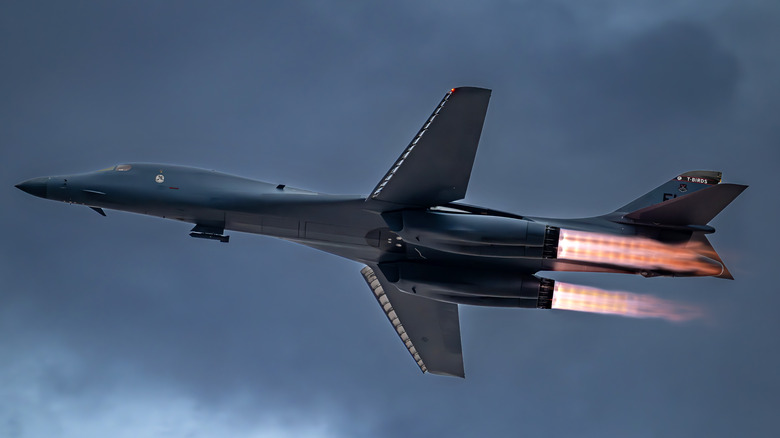Why The US Air Force Is Discontinuing The B-1B Lancer
The origins of American-made bomber aircraft go back to the first World War with the introduction of the Martin Aircraft GMB-1, which was launched in 1918. From this early aircraft made of fabric and wood, with limited weaponry, and carrying a limited amount of ordinance, bombers quickly evolved to huge machines capable of traveling across the European continent in World War II. Further developments were made after the war, which gave rise to even more powerful machines, including contemporary aircraft like the B-52, the longest-serving bomber in the U.S. Air Force, and the B-1B Lancer, which is slated for retirement soon.
Work on the B1-B Lancer began in the 1970s where it was created to supersede the B-52, which at the time was already an old platform, as development on the B-52 began right after WWII. Designed to be more than an upgrade, the B-1B has several vital features its predecessor didn't have. This includes supersonic capability, variable sweep wings, and, more importantly, its 75,000-pound bomb-carrying capacity is bigger than the B-52's 70,000 pound payload. Capable of a top speed of Mach 1.2, and a maximum range of 7,450 miles,the B-1B bomber is one of the most capable bomber aircraft built.
The B-1B Lancer has had a long service and has proven abilities, but despite this tenure, is now set for discontinuation. Citing age, maintenance, and operational costs as the basis for its phaseout, other factors include the considerable degradation to its components and airframe. This isn't surprising given the highly strenuous missions it flew and the wear and tear caused by desert areas it was deployed to. Lastly, similarly to why the legendary F-14 Tomcat was cancelled, the B-1B's comparable mechanical variable wing system requires complex and costly servicing.
A proven platform now retiring
With the Air Force's imminent phase-out of the B-1B, the B-2 Spirit and the B-52 Stratofortress will be the only bombers in its fleet. However, another aircraft may take the Lancer's place, as the B-21 Raider is going through numerous systems, weapons, and operations tests before it's approved for mass production. Expected to come into service by the middle of the 2020s, the new bomber program has planned for an initial build of 100 units of the B-21, with the first units to be deployed to Ellsworth Air Force Base in South Dakota
The B-1B Lancer is a product of the military requirements during the Cold War, and as a result, many of its systems are now out of date. While there have been several upgrades made to the B-1B Lancer to modernize and improve its capabilities, the B-21 Raider has several advantages that the B-1B is incapable of. Designed to be a more versatile platform than its forerunners, the B-21 combines better stealth potential, a longer range, and most importantly, the ability to carry new-generation weapons — like hypersonic missiles.
Since it entered service in the mid-1980s, the Lancer has been a vital component of the United States Air Force bomber fleet. Surprisingly, while the B-1B was meant to be a stand-in, it has remained in service for 40 years, where it had a projected service life of just ten years, just until the more advanced B-2 bomber became operational. From a production run of 100, there are 60 B-1B bombers still in service, and all are initially slated for phaseout by the next decade, interestingly, despite being older, the B-52 it replaced is scheduled to continue flying for another 30-plus years.

